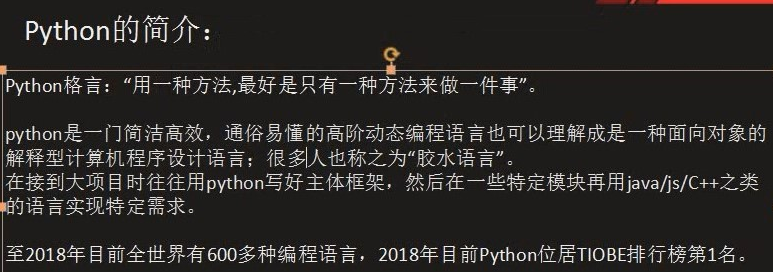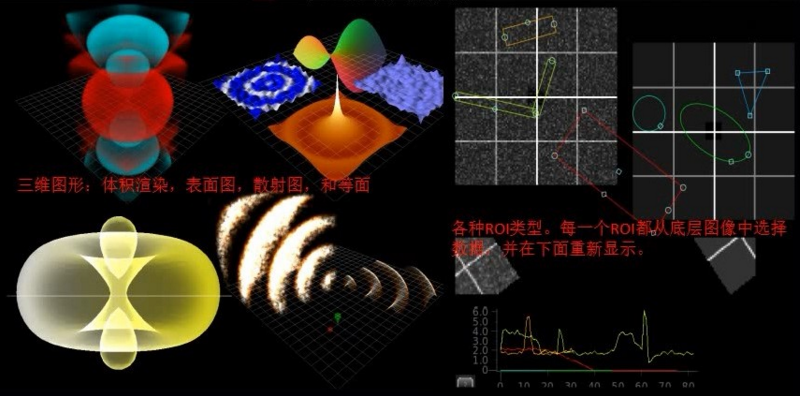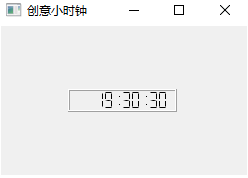【本实验内容】
1.GUI、PyQT5介绍
2.实现此次实验效果
2.实现此次实验效果
【一 GUI、PyQt5介绍】
1.Python简介

2.GUI介绍
几个常用的Python GUI库:
(1)wxPython
(2)tkinter
(3)PyQt5

利用PyQt完成的项目效果展示:





【二 实现此次项目效果】
注意:后面代码都是在前面的基础上添加的;
>>>导入模块:
1 from PyQt5.QtGui import * # QtGui:对系统及窗口的操作
2 from PyQt5.QtCore import * # QtCore:包含一些核心的应用,例如时间模块等;
3 # QDesktopWidget:包含了屏幕的尺寸
4 from PyQt5.QtWidgets import QWidget,QDesktopWidget,QLCDNumber,QVBoxLayout,QApplication
5 import sys>>>先编写一个闹钟程序的主窗口:
1 # “ADD1”
2 class MyTime(QWidget):
3 """
4 面向对象的特点:封装、继承、多态---(类、方法、数据)
5 __init__是python语言里面的构造方法
6 """
7 def __init__(self):
8 # 用于解决多重继承的问题
9 super().__init__()
10 self.initUI()
11
12 # 绘制UI界面
13 def initUI(self):
14 # 窗口组件大小 250px像素 150
15 self.resize(250,150)
16 # self.move(300,300)
17 # 窗口标题:
18 self.setWindowTitle("创意小时钟-香")
19 self.show()
20 # “ADD2”
21 if __name__ == '__main__':
22 # 创建一个QT应用对象
23 app = QApplication(sys.argv)
24 m_time = MyTime()
25 sys.exit(app.exec_())
26 # app.exex_()>>> 此时运行程序就可以初步构建一个轮廓了,效果如下:

>>>附截止目前的完整代码如下:


1 from PyQt5.QtGui import * # QtGui:对系统及窗口的操作
2 from PyQt5.QtCore import * # QtCore:包含一些核心的应用,例如时间模块等;
3 # QDesktopWidget:包含了屏幕的尺寸
4 from PyQt5.QtWidgets import QWidget, QDesktopWidget, QLCDNumber, QVBoxLayout, QApplication
5 import sys
6
7 # “ADD1”
8 class MyTime(QWidget):
9 """
10 面向对象的特点:封装、继承、多态---(类、方法、数据)
11 __init__是python语言里面的构造方法
12 """
13
14 def __init__(self):
15 # 用于解决多重继承的问题
16 super().__init__()
17 self.initUI()
18
19 # 绘制UI界面
20
21 def initUI(self):
22 # 窗口组件大小 250px像素 150
23 self.resize(250, 150)
24 # self.move(300,300)
25 # 窗口标题:
26 self.setWindowTitle("创意小时钟-香")
27 self.show()
28
29 # “ADD2”
30 if __name__ == '__main__':
31 # 创建一个QT应用对象
32 app = QApplication(sys.argv)
33 m_time = MyTime()
34 sys.exit(app.exec_())
35 # app.exex_()
窗口名字默认左上角,
可以设置的;
>>>此时,时钟程序没有在正中心,因此进行继续编程解决这个问题:
1 # “ADD2”
2 # 调用
3 self.move_center() # 在initUI()方法的self.show()语句前面增加
4
5 # “ADD1”
6 def move_center(self):
7 # 拿到主窗口的矩形
8 m_rect = self.frameGeometry()
9 # 获得整个屏幕的绝对值,从中得到屏幕的中心点
10 w_center_top = QDesktopWidget().availableGeometry().center()
11 m_rect.moveCenter(w_center_top)
12 # 从左向右边移动,直到屏幕中间的位置
13 self.move(m_rect.topLeft())>>>现在运行,时钟程序窗口居中了:

>>>附截止目前的完整代码如下:


1 from PyQt5.QtGui import * # QtGui:对系统及窗口的操作
2 from PyQt5.QtCore import * # QtCore:包含一些核心的应用,例如时间模块等;
3 # QDesktopWidget:包含了屏幕的尺寸
4 from PyQt5.QtWidgets import QWidget, QDesktopWidget, QLCDNumber, QVBoxLayout, QApplication
5 import sys, time
6
7
8 class MyTime(QWidget):
9 """
10 面向对象的特点:封装、继承、多态---(类、方法、数据)
11 __init__是python语言里面的构造方法
12 """
13
14 def __init__(self):
15 # 用于解决多重继承的问题
16 super().__init__()
17 self.initUI()
18 # 绘制UI界面
19
20 def initUI(self):
21 # 窗口组件大小 250px 150
22 self.resize(250, 150)
23 # self.move(300,300)
24 # 窗口标题:
25 self.setWindowTitle("创意小时钟-香")
26 # 调用
27 self.move_center() # “ADD2”
28 self.show()
29 # “ADD1”
30 def move_center(self):
31 # 拿到主窗口的矩形
32 m_rect = self.frameGeometry()
33 # 获得整个屏幕的绝对值,从中得到屏幕的中心点
34 w_center_top = QDesktopWidget().availableGeometry().center()
35 m_rect.moveCenter(w_center_top)
36 # 从左向右边移动,直到屏幕中间的位置
37
38
39 if __name__ == '__main__':
40 # 创建一个QT应用对象
41 app = QApplication(sys.argv)
42 m_time = MyTime()
43 sys.exit(app.exec_())
44 # app.exex_()>>>现在编程里面的LED数字时钟:
1 import time # “ADD1”:增加时间time模块
2
3 # “ADD2 在initUI()方法的self.show()语句后面增加
4 self.lcd = QLCDNumber()
5 # 设置显示的个数
6 self.lcd.setDigitCount(10)
7 # 设置显示的模式为十进制的
8 self.lcd.setMode(QLCDNumber.Dec)
9 # 设置显示的模式为 平面模式
10 self.lcd.setSegmentStyle(QLCDNumber.Flat)
11 # 获取本地时间
12 self.lcd.display(time.strftime("%X", time.localtime()))
13 self.main_layout = QVBoxLayout()
14 # 将显示的组件添加到盒子布局里面
15 self.main_layout.addWidget(self.lcd)
16 # 设置组件在布局的中间位置
17 self.main_layout.setAlignment(Qt.AlignCenter)
18 # 设置给顶层布局
19 self.setLayout(self.main_layout)>>>附截止目前的完整代码如下:
1 from PyQt5.QtGui import * # QtGui:对系统及窗口的操作
2 from PyQt5.QtCore import * # QtCore:包含一些核心的应用,例如时间模块等;
3 # QDesktopWidget:包含了屏幕的尺寸
4 from PyQt5.QtWidgets import QWidget, QDesktopWidget, QLCDNumber, QVBoxLayout, QApplication
5 import sys,time # “ADD1”:增加时间time模块
6
7
8
9 class MyTime(QWidget):
10 """
11 面向对象的特点:封装、继承、多态---(类、方法、数据)
12 __init__是python语言里面的构造方法
13 """
14
15 def __init__(self):
16 # 用于解决多重继承的问题
17 super().__init__()
18 self.initUI()
19
20 # 绘制UI界面
21
22 def initUI(self):
23 # 窗口组件大小 250px像素 150
24 self.resize(250, 150)
25 # self.move(300,300)
26 # 窗口标题:
27 self.setWindowTitle("创意小时钟-香")
28 # 调用
29 self.move_center()
30 self.show()
31
32 # "ADD2
33 self.lcd = QLCDNumber()
34 # 设置显示的个数
35 self.lcd.setDigitCount(10)
36 # 设置显示的模式为十进制的
37 self.lcd.setMode(QLCDNumber.Dec)
38 # 设置显示的模式为 平面模式
39 self.lcd.setSegmentStyle(QLCDNumber.Flat)
40 # 获取本地时间
41 self.lcd.display(time.strftime("%X", time.localtime()))
42 self.main_layout = QVBoxLayout()
43 # 将显示的组件添加到盒子布局里面
44 self.main_layout.addWidget(self.lcd)
45 # 设置组件在布局的中间位置
46 self.main_layout.setAlignment(Qt.AlignCenter)
47 # 设置给顶层布局
48 self.setLayout(self.main_layout)
49
50 def move_center(self):
51 # 拿到主窗口的矩形
52 m_rect = self.frameGeometry()
53 # 获得整个屏幕的绝对值,从中得到屏幕的中心点
54 w_center_top = QDesktopWidget().availableGeometry().center()
55 m_rect.moveCenter(w_center_top)
56 # 从左向右边移动,直到屏幕中间的位置
57 self.move(m_rect.topLeft())
58
59 if __name__ == '__main__':
60 # 创建一个QT应用对象
61 app = QApplication(sys.argv)
62 m_time = MyTime()
63 sys.exit(app.exec_())
64 # app.exex_()>>>现在运行一下,查看结果,但是现在的问题是,时钟上是静态的?

现在解决这个时钟实时更新这个问题。
>>>ADD1 写一个有关定时器的“槽与信号”的函数:
1 def init_timer(self):
2 # 提供了定时器信号和单出发定时器
3 self.timer = QTimer()
4 # 每间隔1秒就出发一次 timeout信号
5 self.timer.setInterval(1000)
6 self.timer.start() # 启动这个定时器
7 self.timer.timeout.connect(self.update_timer) # 信号和槽函数>>>ADD2写一个输出本地实时时间的函数:
1 def update_timer(self):
2 # 获取本地时间
3 self.lcd.display(time.strftime("%X", time.localtime()))
注意: 删除原来initUI()函数中的此行
# # 获取本地时间
# self.lcd.display(time.strftime("%X", time.localtime()))
>>>ADD3:调用“信号与槽函数”1 # ADD3:
2 self.init_timer()>>>现在运行,结果时钟可以实时更新时间了:

>>>附截止目前的完整代码如下:


1 from PyQt5.QtGui import * # QtGui:对系统及窗口的操作
2 from PyQt5.QtCore import * # QtCore:包含一些核心的应用,例如时间模块等;
3 # QDesktopWidget:包含了屏幕的尺寸
4 from PyQt5.QtWidgets import QWidget, QDesktopWidget, QLCDNumber, QVBoxLayout, QApplication
5 import sys,time # “ADD1”
6
7
8
9 class MyTime(QWidget):
10 """
11 面向对象的特点:封装、继承、多态---(类、方法、数据)
12 __init__是python语言里面的构造方法
13 """
14
15 def __init__(self):
16 # 用于解决多重继承的问题
17 super().__init__()
18 self.initUI()
19 # ADD3:
20 self.init_timer()
21 # 绘制UI界面
22 # ADD1:
23 def init_timer(self):
24 # 提供了定时器信号和单出发定时器
25 self.timer = QTimer()
26 # 每间隔1秒就出发一次 timeout信号
27 self.timer.setInterval(1000)
28 self.timer.start() # 启动这个定时器
29 self.timer.timeout.connect(self.update_timer) # 信号和槽函数
30 # ADD2:
31 def update_timer(self):
32 # 获取本地时间
33 self.lcd.display(time.strftime("%X", time.localtime()))
34
35 def initUI(self):
36 # 窗口组件大小 250px像素 150
37 self.resize(250, 150)
38 # self.move(300,300)
39 # 窗口标题:
40 self.setWindowTitle("创意小时钟-香")
41 # 调用
42 self.move_center()
43 self.show()
44
45 self.lcd = QLCDNumber()
46 # 设置显示的个数
47 self.lcd.setDigitCount(10)
48 # 设置显示的模式为十进制的
49 self.lcd.setMode(QLCDNumber.Dec)
50 # 设置显示的模式为 平面模式
51 self.lcd.setSegmentStyle(QLCDNumber.Flat)
52
53 # # 获取本地时间
54 # self.lcd.display(time.strftime("%X", time.localtime()))
55 self.main_layout = QVBoxLayout()
56 # 将显示的组件添加到盒子布局里面
57 self.main_layout.addWidget(self.lcd)
58 # 设置组件在布局的中间位置
59 self.main_layout.setAlignment(Qt.AlignCenter)
60 # 设置给顶层布局
61 self.setLayout(self.main_layout)
62
63 def move_center(self):
64 # 拿到主窗口的矩形
65 m_rect = self.frameGeometry()
66 # 获得整个屏幕的绝对值,从中得到屏幕的中心点
67 w_center_top = QDesktopWidget().availableGeometry().center()
68 m_rect.moveCenter(w_center_top)
69 # 从左向右边移动,直到屏幕中间的位置
70 self.move(m_rect.topLeft())
71
72 if __name__ == '__main__':
73 # 创建一个QT应用对象
74 app = QApplication(sys.argv)
75 m_time = MyTime()
76 sys.exit(app.exec_())
77 # app.exex_()
发现,它的背景颜色太单调了,这时PyQt5中有一个“调色板”:
>>>ADD1:实例化一个调色板
1 # 实例化一个调色板
2 self.main_pl = QPalette()
3 # 设置背景颜色为深黄色
4 # self.main_pl.setColor(QPalette.Background,Qt.darkRed)
5 self.main_pl.setColor(QPalette.Background, Qt.darkYellow)
6 # 设置窗体自动填充背景颜色
7 self.setAutoFillBackground(True)
8 self.setPalette(self.main_pl)>>> 现在运行,查看结果:

>>>附截止目前的完整代码如下:


1 from PyQt5.QtGui import * # QtGui:对系统及窗口的操作
2 from PyQt5.QtCore import * # QtCore:包含一些核心的应用,例如时间模块等;
3 # QDesktopWidget:包含了屏幕的尺寸
4 from PyQt5.QtWidgets import QWidget, QDesktopWidget, QLCDNumber, QVBoxLayout, QApplication
5 import sys,time # “ADD1”
6
7
8
9 class MyTime(QWidget):
10 """
11 面向对象的特点:封装、继承、多态---(类、方法、数据)
12 __init__是python语言里面的构造方法
13 """
14
15 def __init__(self):
16 # 用于解决多重继承的问题
17 super().__init__()
18 self.initUI()
19 self.init_timer()
20 # 绘制UI界面
21
22 def init_timer(self):
23 # 提供了定时器信号和单出发定时器
24 self.timer = QTimer()
25 # 每间隔1秒就出发一次 timeout信号
26 self.timer.setInterval(1000)
27 self.timer.start() # 启动这个定时器
28 self.timer.timeout.connect(self.update_timer) # 信号和槽函数
29
30 def update_timer(self):
31 # 获取本地时间
32 self.lcd.display(time.strftime("%X", time.localtime()))
33
34 def initUI(self):
35 # 窗口组件大小 250px像素 150
36 self.resize(250, 150)
37 # self.move(300,300)
38 # 窗口标题:
39 self.setWindowTitle("创意小时钟-香")
40 # 调用
41 self.move_center()
42 # ADD1:实例化一个调色板
43 # 实例化一个调色板
44 self.main_pl = QPalette()
45 # 设置背景颜色为深黄色
46 # self.main_pl.setColor(QPalette.Background,Qt.darkRed)
47 self.main_pl.setColor(QPalette.Background, Qt.darkYellow)
48 # 设置窗体自动填充背景颜色
49 self.setAutoFillBackground(True)
50 self.setPalette(self.main_pl)
51
52 self.show()
53 self.lcd = QLCDNumber()
54 # 设置显示的个数
55 self.lcd.setDigitCount(10)
56 # 设置显示的模式为十进制的
57 self.lcd.setMode(QLCDNumber.Dec)
58 # 设置显示的模式为 平面模式
59 self.lcd.setSegmentStyle(QLCDNumber.Flat)
60
61 # # 获取本地时间
62 # self.lcd.display(time.strftime("%X", time.localtime()))
63 self.main_layout = QVBoxLayout()
64 # 将显示的组件添加到盒子布局里面
65 self.main_layout.addWidget(self.lcd)
66 # 设置组件在布局的中间位置
67 self.main_layout.setAlignment(Qt.AlignCenter)
68 # 设置给顶层布局
69 self.setLayout(self.main_layout)
70
71 def move_center(self):
72 # 拿到主窗口的矩形
73 m_rect = self.frameGeometry()
74 # 获得整个屏幕的绝对值,从中得到屏幕的中心点
75 w_center_top = QDesktopWidget().availableGeometry().center()
76 m_rect.moveCenter(w_center_top)
77 # 从左向右边移动,直到屏幕中间的位置
78 self.move(m_rect.topLeft())
79
80 if __name__ == '__main__':
81 # 创建一个QT应用对象
82 app = QApplication(sys.argv)
83 m_time = MyTime()
84 sys.exit(app.exec_())
85 # app.exex_()>>>最后此项目的完整代码如下:
1 from PyQt5.QtGui import * # QtGui:对系统及窗口的操作
2 from PyQt5.QtCore import * # QtCore:包含一些核心的应用,例如时间模块等;
3 # QDesktopWidget:包含了屏幕的尺寸
4 from PyQt5.QtWidgets import QWidget,QDesktopWidget,QLCDNumber,QVBoxLayout,QApplication
5 import sys,time
6
7
8 class MyTime(QWidget):
9 """
10 面向对象的特点:封装、继承、多态---(类、方法、数据)
11 __init__是python语言里面的构造方法
12 """
13 def __init__(self): # self指的是类实例对象的本身(PS:不是类本身)
14 # 用于解决多重继承的问题
15 super().__init__()
16 self.initUI()
17 self.init_timer()
18 def init_timer(self):
19 # 提供了定时器信号和单出发定时器
20 self.timer = QTimer()
21 # 每间隔1秒就出发一次 timeout信号
22 self.timer.setInterval(1000)
23 self.timer.start() # 启动这个定时器
24 self.timer.timeout.connect(self.update_timer) # 信号和槽函数
25 def update_timer(self):
26 # 获取本地时间
27 self.lcd.display(time.strftime("%X", time.localtime()))
28
29
30
31 # 绘制UI界面
32 def initUI(self):
33 # 窗口组件大小 250px 150
34 self.resize(250,150)
35 # self.move(300,300)
36 # 窗口标题:
37 self.setWindowTitle("创意小时钟-香")
38 # 调用
39 self.move_center()
40
41 # 实例化一个调色板
42 self.main_pl = QPalette()
43 # 设置背景颜色为深黄色
44 # self.main_pl.setColor(QPalette.Background,Qt.darkRed)
45 self.main_pl.setColor(QPalette.Background, Qt.darkYellow)
46 # 设置窗体自动填充背景颜色
47 self.setAutoFillBackground(True)
48 self.setPalette(self.main_pl)
49
50 # 字体颜色的设置:这里有问题:
51 # self.main_pl = QPalette()
52 # self.main_pl.setColor(QPalette.Normal, QPalette.windowText,Qt.darkBlue)
53 # self.setAutoFillBackground(True)
54 # self.setPalette(self.main_pl)
55
56 # 显示布局
57 self.show()
58
59 self.lcd = QLCDNumber()
60 # 设置显示的个数
61 self.lcd.setDigitCount(10)
62 # 设置显示的模式为十进制的
63 self.lcd.setMode(QLCDNumber.Dec)
64 # 设置显示的模式为 平面模式
65 self.lcd.setSegmentStyle(QLCDNumber.Flat)
66 # 实例化盒子布局
67 self.main_layout = QVBoxLayout()
68 # 将显示的组件添加到盒子布局里面
69 self.main_layout.addWidget(self.lcd)
70 # 设置组件在布局的中间位置
71 self.main_layout.setAlignment(Qt.AlignCenter)
72 # 设置给顶层布局
73 self.setLayout(self.main_layout)
74
75 def move_center(self):
76 # 拿到主窗口的矩形
77 m_rect = self.frameGeometry()
78 # 获得整个屏幕的绝对值,从中得到屏幕的中心点
79 w_center_top = QDesktopWidget().availableGeometry().center()
80 m_rect.moveCenter(w_center_top)
81 # 从左向右边移动,直到屏幕中间的位置
82 self.move(m_rect.topLeft())
83 if __name__ == '__main__':
84 # 创建一个QT应用对象
85 app = QApplication(sys.argv)
86 m_time = MyTime()
87 sys.exit(app.exec_())
88 # app.exex_()The end!

**************************************************************************************************
Good lucky to you
**************************************************************************************************
来源:oschina
链接:https://my.oschina.net/u/4382335/blog/3868025